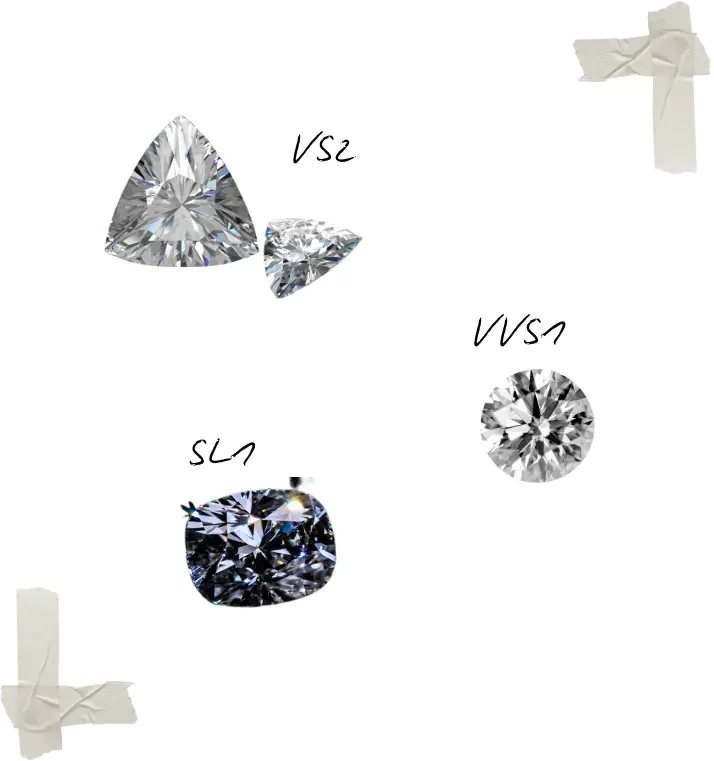One of the 4Cs that defines a diamond’s quality is clarity – a measure of its internal and external characteristics. But what does clarity mean? How is it graded? And ultimately, what do you need to consider when you’re choosing your diamond (or what do we do when we’re sourcing it for you!)?
What Does Clarity Mean?
Clarity refers to the presence (or absence) of inclusions (internal imperfections) and blemishes (surface imperfections) within a diamond. These tiny flaws are a natural part of how diamonds form under intense heat and pressure deep within the earth (or, in the case of lab-grown diamonds, above-ground).
While inclusions might sound undesirable, they’re often so microscopic that they don’t affect the beauty of a diamond. In fact, many inclusions are considered a diamond’s fingerprint, making each one special and unique – just like the relationships they celebrate.
For lab-grown diamonds, inclusions like metallic particles (from the High Pressure High Temperature, or HPHT, process) or striations (from the Chemical Vapour Deposition, or CVD, process) are more common.

How Clarity is Graded
The diamond industry’s certifying boards use a globally recognised clarity scale. Each diamond is evaluated under 10x magnification to determine the size, type, and location of inclusions:
1. Flawless (FL):
- No inclusions or blemishes visible under 10x magnification.
- Extremely rare and valuable
2. Internally Flawless (IF):
- No internal inclusions, but minor surface blemishes visible under magnification.
- Rare but slightly more accessible than FL.
3. Very, Very Slightly Included (VVS1 and VVS2):
- Inclusions are extremely difficult to detect under magnification.
- Perfect for buyers seeking near-perfection without the premium price tag of FL or IF grades.
4. Very Slightly Included (VS1 and VS2):
- Inclusions are visible under magnification but invisible to the naked eye.
- A sweet spot for balancing beauty and value.
5. Slightly Included (SI1 and SI2)*:
- Inclusions are noticeable under magnification and may be faintly visible to the naked eye.
- Popular for budget-conscious buyers.
6. Included (I1, I2, I3)*:
- Inclusions are obvious under magnification and often visible without magnification.
*Typically not recommended (by us!) for engagement rings.
Lab-Grown Diamond Clarity
Lab-grown diamonds often exhibit unique inclusions, such as:
- Metallic Flux Inclusions (common in HPHT diamonds): Tiny metallic particles from the growth process.
- Graining or Striations (common in CVD diamonds): Fine growth lines that may appear faintly under magnification.
Clarity and Value
While clarity impacts a diamond’s value, it’s often unnecessary to chase perfection. For most buyers, inclusions graded at VS2 or SI1 are invisible to the naked eye, offering excellent value. Your certificate’s clarity grading ensures that you know exactly what they’re getting, with no hidden surprises.
Lab-grown diamonds tend to have fewer inclusions than mined diamonds due to their controlled growth conditions. However, inclusions in both types are graded using the same standards.
Mined vs. Lab-Grown Diamonds: Clarity Comparison
| CLARITY GRADE | MINED DIAMOND PRICE (2CT) | LAB-GROWN DIAMOND PRICE (2CT) |
| Flawless (FL) | £35,000+ | £8,000–£10,000 |
| VS1 (Very Slightly) | £18,000–£22,000 | £4,000–£6,000 |
| SI1 (Slightly) | £12,000–£15,000 | £2,000–£3,000 |
Lab-grown diamonds typically cost 50–70% less than their mined counterparts while maintaining comparable beauty and quality. The grading expertise offered ensures buyers can trust these stones without overpaying for natural alternatives.
How to Choose the Right Clarity for Lab-Grown Diamonds
- Trust The Certificate: Clarity grading is reliable and transparent, offering clear insights into a diamond’s inclusions and their visibility.
- Prioritise Value Over Perfection: Grades like VS2 or SI1 often appear flawless to the naked eye, providing great value without sacrificing appearance.
- Consider The Setting: Many inclusions are hidden by settings like halos or bezels, making slightly lower clarity grades a smart choice.
- Ask About Growth Method: HPHT diamonds may have different inclusions than CVD diamonds. Understanding these traits can help you decide which type fits your preferences.
Clarity is an essential aspect of a diamond’s beauty, but it doesn’t need to break the bank. Thanks to our expertise in lab-grown diamonds, you can confidently choose a stone with stunning clarity at a fraction of the cost of mined diamonds. Find the perfect stone for your story… Book a consultation with our lab grown diamond experts today!



